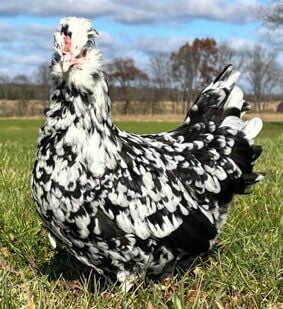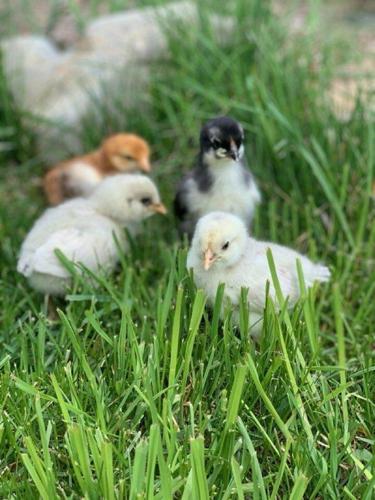Cookies and Cream.
It’s not just a popular ice cream flavor, it’s a dazzlingly beautiful breed of hybrid chicken.
The full name is “Lisa Steele’s Cookies and Cream,” and it’s the result of a collaboration between Meyer Hatchery out of Polk, Ohio, and Steele, a fifth-generation chicken keeper dubbed the “Queen of the Coop” by the media.
Steele turned her enthusiasm for raising backyard chickens into a television show, a popular blog, natural poultry products and a series of books under the brand “Fresh Eggs Daily.”
Lisa Steele’s Cookies and Cream is her second collaboration with the Ohio hatchery — following development of the Steele Egger and the Steele Egger Bantam.
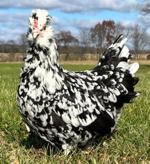
The Cookies and Cream chicken that Meyer Hatchery developed based on Lisa Steele's description of her perfect chicken.
“A few years ago, they asked if I could design my perfect chicken, what would it look like?” Steele said.
Subsequent conversations ensued regarding characteristics such as appearance, laid egg color, and exhibited production and temperament.
“They took all that input from me, and then they kind of went into their secret labs,” Steele said.
“About a year or two later — you don’t just come up with a breed but you have to do several generations and all that — they came out with this Cookies and Cream, which is adorable, and people are loving it. They didn’t even tell me what breeds they used to create it because it is proprietary.”
Meyer Hatchery explains on its website that hybrid chicks are created by crossing two different parents and that they will not breed true: “Crosses are generally created for vigor and production qualities but also for desired traits, such as egg color or feather patterns.”
While commercial operations utilize hybrids that grow fast and heavy (for broilers or meat birds) or lay a lot of eggs, Steele said hybrids for backyard enthusiasts are mostly about having fun.
While Steele said she’s fully committed to raising and protecting heritage breeds that do breed true, the unusual hybrids released by hatcheries such as Meyer, offer a novelty that keeps people interested in maintaining a backyard flock.
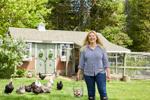
"Queen of the Coop" Lisa Steele with her chickens at her home in Maine.
“There’s a reason why the different breeds exist, and I think if we just all started mixing them together, they would all just look the same, and that would be boring,” she said. “I’m an advocate of purebred, but I think it’s fun, some of these limited new breeds that are coming out. They get people excited. It is something different. So, it was a really fun experience, and it is a really cute little chicken.”
Hybrid Hype
Michael Persia, a poultry nutrition Extension specialist at Virginia Tech, said a trend toward interesting backyard hybrids reflects what occurred with the commercial poultry industry in the 1940s.
“The first thing that that sort of takes me to is back to when breeding and genetics was really first developed,” Persia said. “And this was actually done in the Delmarva area.”
It all began with the “Chicken of Tomorrow Contest” sponsored by the grocery store chain A&P in partnership with USDA. Farmers and breeders brought hatching eggs to facilities where the chicks were hatched and then raised in controlled conditions. A $10,000 prize was offered nationwide.
“It really was sort of the first genetic selection of chickens to try to generate what we now know as our modern birds,” he said. “It was taking the existing genetics and trying to move them in specific ways that, from a broiler standpoint, is going to result in a bigger bird.”
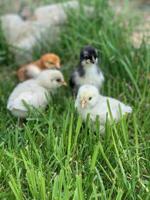
Chicks in the grass.
Eventually, he said, that turned into not just a bigger bird but also a more efficient bird.
“Utilizing the feed that it receives more efficiently to put on weight gain and not wasting that feed,” Persia said. “And then ultimately, the selection turned to other parameters — white meat, or the larger prevalence of white meat, was an important selection criteria over the years. And currently, in addition to our production parameters, we’re also looking at a lot of health and welfare components as well.
“But this idea sort of reminds me of how it first started, and it was just people taking birds and experimenting with them on their own.”
Besides selecting for desired characteristics — whether that be from a production or backyard enthusiast standpoint — there are other advantages to crossbreeding, Persia said.
“The offspring from crossbreeding typically is a little bit healthier, a little bit stronger,” he said. “We call that hybrid vigor.”
Even so, heritage breeds maintain an important role, Persia said.
“I think any time you can maintain divergence within genetic strains, I think that’s always going to be seen as a good thing,” he said. “You can have something that comes in from something unexpected, and if we’ve selected all the resistance for that out of our modern, commercial strains, having those heritage strains there to fall back on I think is a good thing.”
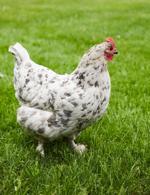
A Splash Marans hen.
Persia said he remains amazed by the amount of diversity in modern poultry genetics.
“It’s very similar to the diversity we have in canine species,” he said. “We have our broiler chickens that grow really fast. They would be sort of those large-frame breeds from a dog standpoint. And then we’ve got our egg layers, which typically are very reproductively sound, but really small birds. So, they would be more like the small or the mini-breeds that have been developed. There’s a lot of similarity between the diversity we see in canine and poultry genetics.”


